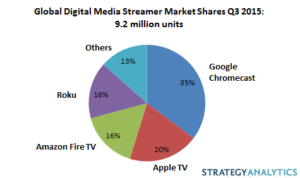Competition for control of the living room between Apple, Roku, Google and Amazon is intensifying as each brand looks to establish an advantage over the other through the launch of new innovative device hardware and software. If success is measured on device popularity alone then Google is certainly winning the race according to the new Strategy Analytics Connected Home Devices (CHD) report “Global Connected TV Device Vendor Market Share: Q3 2015.”
Global shipments of all Connected TV Devices (including Smart TVs, Blu-ray players, Game Consoles and Digital Media Streamers) reached 53 million units in Q3 and are on target to hit 221 million units for the full year, representing growth of 17%.
Samsung continues to dominate the global Smart TV market from LG and Sony and it now accounts for 1 in 4 Smart TVs in use worldwide. During the quarter, Philips joined Sony and Sharp in offering Smart TVs with Google’s Android TV platform in a number of its mid to high end ranges. Android TV captured an estimated 8-10% share of the overall Smart TV market during Q3.
Within the Game Console market, Sony shipped more than double the number of consoles as Microsoft in the quarter although the Xbox One is expected to close the gap on the PS4 during the final quarter thanks to its appealing 1st and 3rd party bundles.
Quotes:
David Watkins, Service Director, Connected Home Devices service said, “Despite the growing penetration of integrated Smart TVs, Digital Media Streamers such as Chromecast and Fire TV continue to prove popular with consumers thanks to their low cost and effectiveness at bridging the gap between the Internet and the TV screen. While the long term viability of such devices will be threatened by advancements in Smart TV technology, they are currently acting as significant components in Apple, Google and Amazon’s fast evolving TV and video ecosystems.”
Chirag Upadhyay, Senior Research Analyst, Connected Home Devices service added, “The growing adoption of Connected TV Devices in the home proves that the living room TV screen is still the dominant medium for consuming TV and video content. The collective viewing experience cannot be replicated on a smartphone or tablet and so we expect the ‘connected TV screen’ to remain a focal point of homes in the future.”

